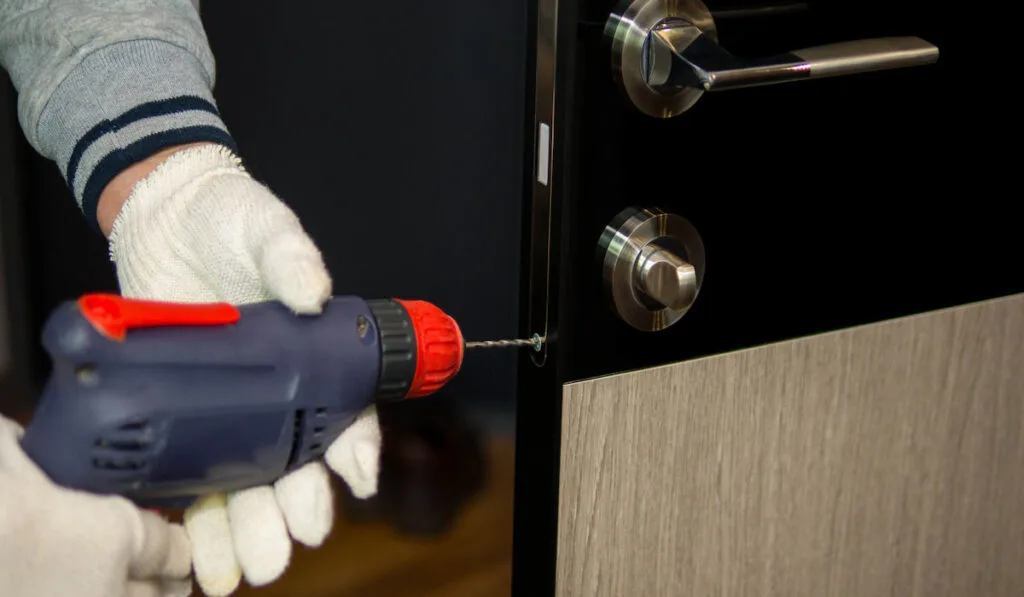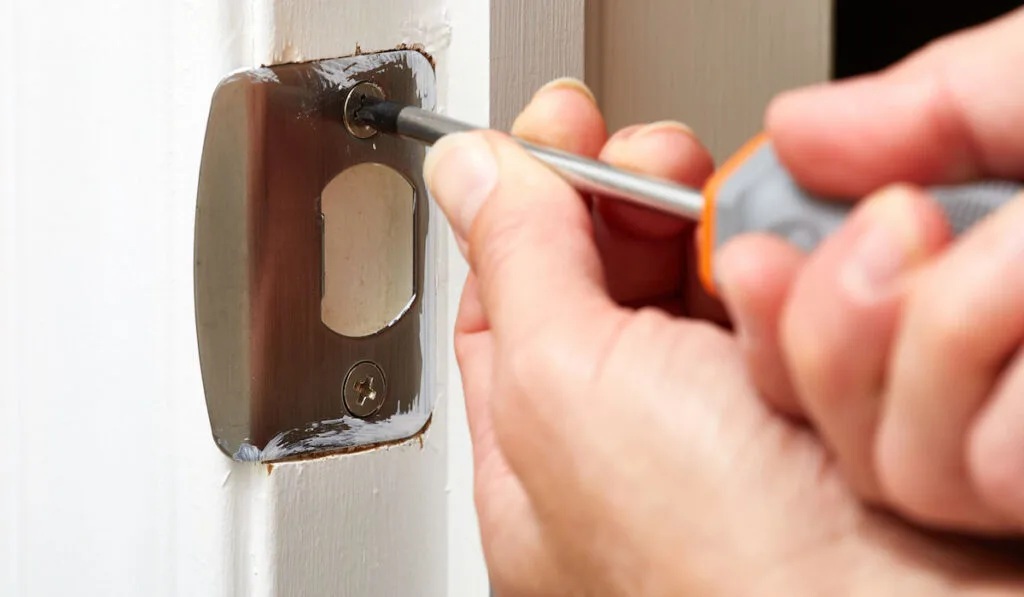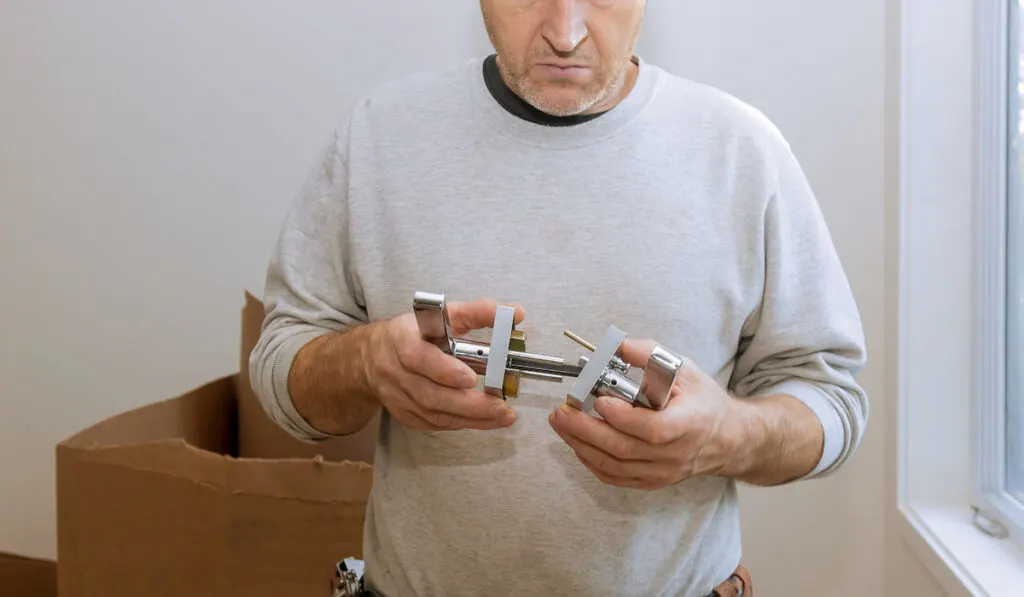*This post may have affiliate links, which means I may receive commissions if you choose to purchase through links I provide (at no extra cost to you). As an Amazon Associate, I earn from qualifying purchases. Please read my disclaimer for additional details.
One of the more irritating things in life is to walk in the door with an armful of groceries and kick the door closed, only for it to bounce right back at you. Of course, this usually happens when you have pets who will immediately see their moment of freedom and make a go for it.
A door thumb latch that won’t retract usually means that you will have to fix the mechanism, replace it, unjam it, realign the strike plate, and fix a misalignment issue between the thumb latch mechanism on one side with the latch on the other side.
There are a number of factors that are potentially at play.

The door thumb latch’s spring bolt is designed to retract when it makes contact with the door frame, then return to its initial position once it slides into the square gap inside the middle of the strike plate.
If the thumb latch spring bolt isn’t retracting, it will simply bounce off of the frame when you try to close the door.
Table of Contents
Fixing a Door Thumb Latch That Won’t Retract
Hopefully, as in most cases, fixing a stubborn door thumb latch shouldn’t require much, besides a little frustration.
- Loosen the latch assembly and lubricate
- Repair or replace the mechanism
- Realign the spindle
- Tighten all of your screws
- Realign the strike plate
Realigning the strike plate might seem counterintuitive since the thumb latch does not retract the spring bolt, however, it may only seem that way, which is why we mention it.
The only way to know for sure is to open the door and play around with the spring bolt to ensure you are getting full retraction and extension.
Loosen the Latch Assembly and Lubricate

Sometimes, there may be something as simple as grime or dirt getting into the latch and affecting the spring bolt’s ability to slide back and forth within the lath assembly. If the springboard is stuck cold and unmoving, you can gently tap at it with a hammer to see if it will break free.
If it does, work the spring bolt back and forth to make sure that you’re getting a full retraction and extension that feels smooth. You don’t want to leave it at that though.
Obviously, something got in there and caused the problem, so it stands to reason that you need to ensure that it doesn’t happen again.
Unfortunately, this means that you need to disassemble the entire mechanism because you need to lubricate it and you want to make sure that you get everything.
Disassembling a thumb door latch assembly is as simple as removing a regular doorknob.
What you want to do is get down to the latch assembly, more than anything else, along with the spindle, if you happen to have a standard doorknob on the other side, which a lot of people do.
Use WD-40 to spray the interior mechanism, with extra attention on the deadlatched plunger, (the smaller, secondary cylinder of metal that sits against the straight side of the curved spring bolt.
Realign Your Strike Plate

As we mentioned above, it may only seem as if your thumb latch isn’t retracting because your strike plate is no longer in position and the spring bolt isn’t properly settling into the gap.
The strike plate is usually held on by two screws and depending on how long it has been there, will leave a strike plate depression behind, so you can properly align it.
Some framers will install your door frame with a manufactured depression in the center of the beam, where the strike plate will fit like a Lego. You need to make sure that the strike plate is sitting comfortably in this depression.
If the tiny screws have stripped out their holes, which is often the case, you will need to find the exact same diameter wood screw, only add a half an inch to an inch in length.
Use these longer screws to secure your strike plate in place.
Slide the door almost closed and use a flashlight to observe how the spring bolt reacts to your newly secured strike plate.
When you install the strike plate again, also be sure to tighten the screws on the latch assembly.
As homes settle, the framework within the house settles and moves as well. Make sure that your door is level and the hinges are screwed in tight, as the smallest misalignment will move the spring bolt up or down in relation to the strike plate.
Repairing the Latch Mechanism

You can certainly go out and get the small parts necessary to fix the interior mechanism if that’s how you want to do things. However, it’s often just easier to replace it altogether and the cost difference is nearly negligible.
Not only is it negligible, but the work that you do try to repair the damage, some of which may not be readily apparent, may end up costing you more in terms of replacement hardware than just buying a new latch altogether.
If your thumb latch mechanism is a part of an exterior door, then replacing the latch is the fastest and most efficient method for getting your door to close again so your home retains the privacy and protection you expect.
Realigning the Spindle

Oftentimes, a thumb latch mechanism is on one side of the door while a round, standard knob is on the other, which has a little more complicated spindle, but either way, it’s not a big issue realigning it. If the interior mechanism is just the tiniest bit off, it can cause a “sticky” spring bolt.
When it comes to a thumb latch, it turns the spindle differently than a door knob.
On a door knob, the spindle is turned with the door knob. As it spins, it pushes the mechanism that retracts the spring bolt backward.
A thumb latch does the same thing but it does it with a separate, spring mechanism.
As you press down on the thumb plate, an interior spring platform rises up and it’s designed to turn the spindle as it does so, which retracts the spring bolt.
Everything in here must be perfectly aligned so that you get the full amount of retraction and extension. You should also check the spring mechanism while you are in here.
- Ensure that the spring mechanism for the thumb plate fully extends up and down
- Make sure that it is clean and removed of all dirt and grime
- Watch the spindle turn as you depress the thumb plate/latch and make sure it turns, fully engaging the retraction mechanism
- Make sure that the spindle on the thumb latch is not deformed or degraded
- Check the opposing door knob/latch for all of the same
- Thoroughly clean everything before reassembly or replacement
With a clean spindle moving fluidly, you should be able to get a full retraction of the spring bolt and it should settle back into place, fully extended as well.
All Things Considered
Thumb latches are a unique and aesthetically interesting upgrade to standard doorknobs. Their operation is similar, if not exactly, to a regular door knob and the way you approach fixing them will be similar as well. Fortunately, the fix will be simple enough the majority of the time.
Resources
- https://www.plantedshack.com/what-to-do-when-the-door-latch-wont-retract/
- https://www.hometips.com/repair-fix/door-lock-latch-problems.html
